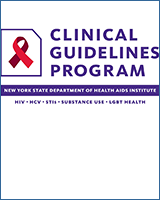|
Laboratory Test
|
Comments
|
| HIV-1 RNA quantitative viral load |
Regular monitoring is the most accurate and meaningful measure of effective ART. Check every 3 to 6 months during years 1 and 2, and every 4 to 6 months thereafter. Monitor every 1 to 3 months if adherence is inconsistent or the patient has a detectable viral load.
|
| CD4 lymphocyte count |
Check every 3 to 6 months if CD4 count <200 cells/mm3; not indicated if viral load is consistently undetectable (CD4 count ≥200 cells/mm3). Monitor every 3 months if the HIV diagnosis is recent (<2 years), viral load suppression is inconsistent, or CD4 count is close to or below 200 cells/mm3. For patients not taking ART, check CD4 cell count every 4 to 6 months.
|
| HIV-1 resistance testing (genotypic) |
Perform at treatment initiation. Perform if HIV RNA (viral load) is ≥500 copies/mL; archive genotype may be considered if viral load is <500 copies/mL. Consult with an expert in HIV care in the event of treatment failure.
|
| G6PD |
Screen for deficiency to avoid complications from the use of oxidant drugs, including dapsone, primaquine, and sulfonamides when starting dapsone or other oxidant drug. Prevalence of G6PD deficiency is highest among people of African, Asian, or Mediterranean descent, but should be considered in all patients given the diversity of backgrounds.
|
| CBC |
For patients who are not taking ZDV, check at ART initiation, and repeat as clinically indicated. For patients who are taking ZDV, check at initiation and 4 weeks after; follow every 3 months for the first year, then every 6 months. Consider CBC with any change in medication.
|
| Estimated glomerular filtration rate |
For patients who are taking TAF or TDF, check at initiation, then repeat at 4 weeks, 3 months, 6 months, and 12 months for the first year, then every 6 months thereafter. For patients who are not taking TDF, check at initiation, at 6 months during the first year, then annually thereafter. Check after initiation of medication with risk for renal disease (e.g., NSAIDs, ACE inhibitors). Check in patients with a history of diabetes or other renal diseases.
|
| Hepatic panel |
Check 3 months after initiating ART or medications with risk for liver disease (e.g., statins, azoles), or if there is a history of viral hepatitis, and then at 12 months. Check every year if a patient is stable and without the above risks.
|
| Random blood glucose (fasting or hemoglobin A1C if high) |
Check yearly if a patient has risk factors for diabetes (family history, obesity, use of PIs or INSTIs). If abnormal, repeat random glucose as a fasting glucose or A1C.
|
| TB screening |
Obtain IGRA TB test (such as T-SPOT or QuantiFERON-TB) or, if IGRA is not available, tuberculin skin test (commonly known as PPD), at baseline for diagnosis of latent TB infection, unless the patient has previously tested positive for or has documented TB. Repeat annually for patients at risk (e.g., unstable housing, incarceration, travel, immigration).
|
| HAV |
|
| HBV |
If HBsAg-positive, perform an HBV DNA viral load test. Repeat the anti-HBs test once after vaccination to ensure immunity.
|
| HCV |
If a patient was previously treated for HCV or is antibody-positive, perform an HCV viral load test. Check at entry to care; repeat as clinically indicated for patients with exposure risk.
|
| Measles titer | Vaccinate if the patient is not immune and has a CD4 count >200 cells/mm3. |
| Varicella titer |
For patients with no evidence of immunity and CD4 count >200 cells/mm3, consider vaccination for chicken pox (Varivax; 2 doses, 3 months apart); engage patients in shared decision-making, taking into consideration the potential risks of a live vaccine. Live vaccines are contraindicated for patients with CD4 counts <200 cells/mm3. For patients aged ≥19 years, regardless of varicella titer status or CD4 cell count, recommend vaccination for herpes zoster with recombinant zoster virus (Shingrix; 2 doses, 2 to 6 months apart).
|
| Urinalysis |
|
| Urine pregnancy test |
|
| Lipid panel |
Perform at least every 3 years if a patient has increased risk for CVD. Consider annual screening if a patient is taking PIs. For adults aged >75 years, initiate discussion of possible benefits of age-appropriate preventive therapies in the context of comorbidities and life expectancy. HIV is considered a risk-enhancing factor for CVD; clinicians may opt to perform more frequent lipid testing in patients with cardiovascular comorbidities.
|
| Serum TSH |
|
| Gonorrhea and chlamydia |
Perform baseline NAAT at oral, anal, urethral, and cervical sites for MSM, transgender women, and others as indicated by individual exposure. Repeat based on risk factors and sites of exposure.
|
| Syphilis |
|
| Trichomonas | Perform screening test if the patient has a vagina and is sexually active. |
| HLA-B*5701 | Must be performed before initiation of abacavir, otherwise not routine. |

